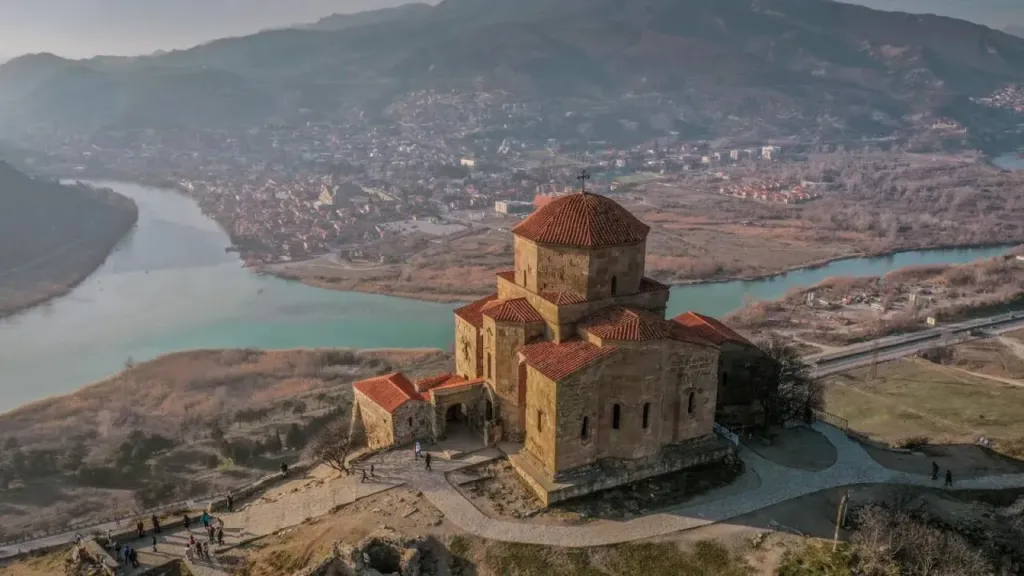Mikhail Lermontov wrote Mtsyri in 1839; it was published in 1840. The Georgian word “mtsyri” means “novice.” The hero escapes from a monastery and spends three days in the wild before he is found exhausted. The poem is rooted in a specific site — the Jvari Monastery above Mtskheta — where “the waters of Aragvi and Kura, embracing like two sisters, merge and roar.” This famous line turned the confluence into a literary symbol of freedom and fate, anchoring the text in a real panorama that invites travel.
Where the place is
Mtskheta, the ancient capital of Georgia, lies roughly 20 kilometers from Tbilisi. High above the town stands the 6th–7th century Jvari Monastery. From its terraces you see the exact curve of the valley and the confluence of the Mtkvari (Kura) and Aragvi rivers recognizable from Lermontov’s verse. The Historic Monuments of Mtskheta, including Jvari, form a UNESCO World Heritage ensemble — not only for architecture but for a landscape that has preserved its unmistakable character since the poet’s time.
Motifs and landscape
Freedom, struggle, and the cost of choice are inscribed into the terrain. Sharp winds and steep slopes build the “tense” geography where every step is an effort. In the poem the hero fights a leopard — an image bound to the Caucasus wilderness and old hunting lore. The confluence you see from Jvari reads as a visual metaphor for “two fates embracing” — the monastery’s quiet and the call of freedom. Walking the paths between viewpoints lets you feel the poem’s dynamism: shifting winds, changing light, and the water’s color bring Lermontov’s “arrows of the storms” to life.
What to see on site
Start at Jvari: a compact cross-in-square church with powerful walls and early Christian details. Circle the church: to the east, Mtskheta and Svetitskhoveli Cathedral; to the south, the Kura valley; to the north, green spurs along the Aragvi. Back in town, step into Svetitskhoveli and Samtavro to widen the historical frame that resonates with Mtsyri’s voice. If time allows, climb neighboring hills for different angles on the confluence and to match imagined “frames” from the poem with real sightlines.
Practical visiting
From Tbilisi, taxis or minibuses reach Mtskheta in about 30–40 minutes. A winding road climbs to Jvari; there is parking and a viewing area. It is an active monastery: dress modestly, keep quiet, and avoid flash photography inside. Early morning and golden hour are best, when soft light models the valley and the confluence looks most sculpted. Spring and autumn offer the strongest contrasts in water and slopes; summers are hot and windy, winters can be piercing on the ridge. Bring water and a windbreaker — it is noticeably cooler at the top.
A Mtsyri-inspired route
A scenic day plan: Tbilisi — Mtskheta (old town stroll and cathedral) — drive up to Jvari — an hour at the viewpoints — descent to the riverside near the confluence (if accessible) — dinner back in Mtskheta. Read key lines aloud as you go to align text and perspectives. Keep three anchors in mind: “mtsyri” as “novice” and the theme of choice, the confluence as a metaphor of fate, and the wind as the mountains’ voice that, in Lermontov, always speaks to the hero. This way the “tourist place” becomes a personal encounter.
Notable facts
Lermontov visited the Caucasus several times, and Mtsyri is among his most “topographic” works. The poem is compact yet rich in imagery, and its “set” — a hilltop monastery, the roar of two rivers, steep trails — awaits you in a single day trip. “I lived but little, and in captivity…” says the hero; standing at Jvari above the vast valley, it is easy to feel why these words still cut deep.
- Bosphorus
- Mongolia
- Bali
- Depths of the Planet: The Most Impressive Depressions of Earth
- The World’s Most Dangerous Countries for Tourism in 2025
- What to know when going to Brazil ?
- The World of Varans
- Great Plains (USA)
- Global traveler risk ranking 2025
- Madagaskar
- Nicaragua
- Traveling to Russia
- Los Angeles
- Lofoten Islands
- Taco – the taste of Mexico in your hand: history, traditions and travel routes
- Hiroshima’s nuclear blast: how tragedy reshaped travel routes
- Paradise for Sea Lovers: World Regions with the Most Swimming Beaches
- Apple in tourism: how the brand became a travel attraction
- Holiday in Monaco
- House of Russian-Korean Friendship Opened in Primorye on the Border with the DPRK











